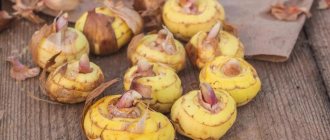Marigolds are a plant familiar to everyone, blooming beautifully in flower beds, ridges, and balconies, decorating flower beds with a colorful variety. But few people know that marigolds and tagets are the names of a crop from the Asteraceae family, originally from America, where it grows wild.
The plant is unpretentious, has a wide variety of varieties, looks great in compositions, group and single plantings, its care is simple - all this has made it popular among a huge variety of flower crops. Growing marigolds is not difficult even for a novice gardener, and more detailed information about the culture will tell you how to plant and when to plant in open ground.
Species diversity of marigolds
The plant, in addition to beautiful bright flowers, has an unusual tart odor, the source of which is phytoncides. Many insect pests cannot tolerate it, so marigolds are planted next to garden crops to repel them, and in the cuisines of southern peoples, tagets are used as a spicy spice. Varieties of marigolds vary in size and shape of flowers, leaves, and height, so when choosing planting material you need to take into account where the flower will be grown.
Kinds:
- Thin-leaved (Mexican) - grows up to 25 cm, strongly branches, leaves are dissected, thin, flowers are small - 1.5 cm in diameter. The color of the flowers is mainly yellow and orange. Ideal for borders, ridges, landscape compositions.
- Rejected (small-flowered, French) - forms a lush bush with flowers (double, simple, semi-double) of yellow-brown, yellow, brown-red color. The leaves are thin, dissected. The variation in height is quite large:
- up to 25cm – dwarf species;
- no higher than 40cm – short;
- up to 50cm – medium;
- 60cm – tall.
- Large-flowered (erect, African) - grows up to 1 m, the leaves are large, dissected, tubular flowers are always yellow in color. The bushes vary in height:
- up to 45cm – short;
- up to 60cm – medium height;
- no higher than 90cm – tall;
- more than 90cm – gigantic.
Description of the plant
In the wild, marigolds are found in the tropical and temperate climates of South and North America, where they grow as a perennial. In the 16th century, the flower was brought to Europe by Spanish colonialists, and in the 18th century, the botanical genus from the Astrov family was described by K. Liney.
Spreading marigold bushes, formed by an erect or branched stem, on which feathery openwork leaves with translucent veins are located alternately or oppositely, depending on the variety, grow in height from 20 cm to 2 m.
Double or simple basket-shaped inflorescences are formed by corollas with a diameter of 1 to 6 centimeters, colored yellow, brown, orange and consisting of a number of fused leaves and reed petals. The flattened black seeds are used for sowing and do not lose their viability for up to 4 years.
Chernobrivtsy or marigolds are undemanding to the composition of the soil, tolerate drought, are not afraid of temperature fluctuations, and are grown as an annual ornamental crop in temperate climates.
Requirements for the site and soil
The site for growing marigolds should be chosen in a sunny, well-lit place. But it should be taken into account that each variety of crop relates to lighting differently, for example, white-flowered varieties (erect hybrids) need light shading in extreme heat, and varieties with thin stems and openwork leaves (thin-leaved) shade is contraindicated - they grow weak and frail .
The crop has no special preferences for soil composition, you just need to know that the root system does not like stagnant moisture and take this into account when planting - heavy soils can be lightened by adding sand.
Preparations for planting begin in the fall - they dig up the area with the addition of humus or compost (4-5 kg per 1 m²), remove weeds and plant roots. To prevent possible stagnation of moisture, you can dig small grooves to drain melt water in the spring.
History of origin
How to correctly say marigolds or marigolds and what family do they belong to? Both names are correct. Marigolds, or marigolds, belong to the Asteraceae or Asteraceae family. These are annual and perennial plants native to America. Wild marigolds can be found from Argentina to New Mexico . Indian tribes actively used the plant in medicine and cooking, as a seasoning, component of sauces and marinades.
In the 16th century, flowers first came to Europe and were successfully cultivated. Nowadays, marigolds are distributed all over the world and decorate street flower beds, city holidays, private gardens and apartments.
Growing marigolds in seedlings
It is difficult to confuse marigold seeds with others - they are long, like thin sticks, with a yellow or beige tuft. They germinate within 2-3 years, but the germination time of the species is different:
- hybrids and erect – 10-12 days;
- hybrids and rejected – 10-18 days;
- hybrids and thin-leaved – 12-18 days.
Seed preparation
Seed germination for any sowing method can be accelerated by treating with a 0.001% solution of heteroauxin or Epin (growth stimulants), keeping it in it for 6-12 hours. This treatment allows you to get seedlings 5-7 days earlier and helps the rapid development of a lush bush and beautiful flowers.
If marigold seeds are planted in open ground, and the spring weather is damp with low temperatures, then it is better not to soak to avoid rotting of the seeds. In this case, they should be sown dry - they will sprout under the prevailing conditions that are favorable to them.
When and how to plant
When to plant seeds for seedlings largely determines the type of plant. Erect and thin-leaved marigolds bloom either in mid-July or early August, so for seedlings, for early flowering, their seeds are sown in early spring - before March 10, and they will begin to bloom in mid-May or the first ten days of June.
Rejected marigolds bloom earlier - mid-June, and sowing seeds in the last days of March will allow them to begin flowering in the third decade of May.
Also, the timing of sowing seeds should be correlated with the climate - young seedling bushes will not tolerate spring frosts after transplanting into the ground, and too mature bushes do not take root well.
Sowing rules:
- pour a layer of expanded clay or crushed stone into a container;
- mix purchased soil, peat, sand, humus in a ratio of 1:1:1:1 or turf soil, humus, sand (3:2:1) and fill the container for planting;
- spread the seeds into moistened grooves 1 cm deep every 4-5 cm, sprinkle with soil mixture;
- cover the containers with film (glass) and place in an unlit place at a temperature of 20°-22°C;
- after germination, the film must be removed and the boxes moved to a bright place with a lower temperature - 17°-18°C;
- If the weather permits, the seedlings are taken out to the balcony, loggia, or veranda for hardening.
Seedling care
Watering is carried out abundantly and infrequently, preventing moisture from stagnating.
Feeding begins 1-2 weeks after germination - green Crystalon is added with the nutrients necessary during this period. In the next feeding (5-6 days before transplanting into the ground), yellow Crystalon is used - it activates root growth and promotes rapid rooting.
Planting seedlings in open ground
The timing of transplanting seedlings into open ground depends on weather conditions. It is allowed to plant young bushes when constant positive day and night temperatures are established. When there is a threat of frost, plantings are covered in any convenient way.
The distance between bushes depends on the type of planting: single, group, in composition. For example, tall varieties can be planted at intervals of 40-50cm in borders or along the edge of the lawn; in compositions they can be planted at the vertices of a triangle with a side of 40-45cm.
Between bushes of medium height a distance of 30-35 cm is maintained, between low bushes (dwarf species) - 20-25 cm.
Overview of varieties
In natural conditions, marigolds are found in clearings of deciduous forests, in meadows, on the banks of reservoirs, and differ in the color of double or simple inflorescences, stem height and bush shape. Among the 50 confirmed species of marigolds, only a few have become widespread.
On lush branching bushes, rejected tagetes from 30 to 60 cm in height, many inflorescences with a diameter of 50 mm are formed. The number of corollas in the varieties Carnival, Harlequin, Little Hero, which represent a rejected type of plant, reaches 90 pieces.
Erect tagetes, which are distinguished by pyramidal bushes and large inflorescences with a diameter of up to 15 cm, grow up to 0.9 m in height. Hybrid varieties are popular among landscape designers and gardeners:
- Aztec Lime Green with terry corollas of yellow-light green color;
- Golden dollar with orange inflorescences and no odor;
- Velvet season with tall bushes and lush spherical corollas.
Thin-leaved, low marigolds with strongly branching shoots and dissected leaves grow from 20 to 40 cm in height, are used to decorate borders, lawns, and delight with many small simple flowers with a red spot at the base. Dwarf varieties of the narrow-leaved species Paprika, Gnome, and Golden Ring have become widespread.
Aniseed marigolds are recognized by the pronounced aroma of tarragon, which is felt at a great distance from the flowerbed. All varieties of this type of flower are accepted in any soil and are not afraid of drought.
Marigolds with bright yellow petals, Lemon Queen and Gliters, are distinguished by their high growth. Hybrids Fantastica, Hawaii attract with large inflorescences. Kilimanjaro and Eskimo varieties surprise with their original white color.
Growing seeds in open ground
Marigold seeds germinate well in the spring when sown in open ground directly at the place of cultivation. You need to wait for the soil to thaw and warm up, and sow in the 2-3rd decade of April or in the 1st decade of May. If the soil is not warmed up well, the seeds may lie in the ground for a long time and lose their germination.
The rules for planting seeds are the same as for planting seedlings. If there is a lot of seed material, you can sow more densely, and then thin out the plants, using the removed bushes as seedlings.
When and how to grow marigold seedlings basic information
As already mentioned, marigolds repel some pests. They are also good for the soil. For example, if you cut off the top parts of the Chernobrovets in the fall and spread them out on beds prepared for spring sowing, then as they decompose, various essential oils will get into the soil. Which in turn will repel various pathogens: fungi, viruses, bacteria.
And the main question that many ask is how best to grow marigolds, in what way. The fact is that seeds do not germinate in all soils; they also need a certain climate, and so on. And in order not to take risks, it is recommended to grow marigold planting material. Moreover, seedlings are already more unpretentious to both soil and climate.
Care of plantings in open ground
The culture is unpretentious and does not require special care, different from other flower crops: watering, weeding, loosening, fertilizing.
Watering requirements
Any variety of tagets looks attractive and beautiful with timely watering. In case of infrequent precipitation, watering is carried out every 7-10 days, trying not to pour water on the flowers and pouring 8-10 liters per 1 m².
Reference! The plant may lose its decorative appearance with infrequent watering and drying out of the soil, but has the ability to quickly recover with regular watering.
Fertilizing
If fertilizers were applied during the autumn digging of the soil, 2-3 fertilizing is carried out during the season.
The first time the planted plants are fed at the very beginning of flowering with complex fertilizers without nitrogen or with a minimum amount of it, so as not to stimulate excessive growth of green mass. Fertilizing with Agricola and Kristalon gives good results.
Spraying with Humate in solution every 10-14 days helps to strengthen the plant, abundant and long flowering.
In case of iron deficiency, when the leaf becomes lighter but the veins remain green (chlorosis disease), use Ferovit or Agricola “For yellowing of leaves.”
Features of watering
Marigolds are saturated with moisture twice a day, but in no case should the watering time coincide with the midday heat. It is better to do this in the morning and evening.
Despite the fact that marigolds are quite tolerant of drought, it is undesirable to allow the soil under them to dry out. Otherwise, the leaves will begin to turn yellow and the buds will droop.
Pest control measures
Marigolds are practically not exposed to pest invasion due to the presence of phytoncides in the composition, but sometimes, due to a combination of unfavorable factors, they can suffer due to spider mites, aphids, slugs or the infectious disease gray rot.
How to fight:
- Aphids suck the juices out of the plant, and it gradually dies due to lack of nutrients. Insecticide preparations Konfidor, Bi-58, Aktara or tobacco infusion will help: tobacco (200g) is infused in hot water (5l) for 2 days, stirring occasionally. The infusion is boiled, allowed to cool, and after straining, 20 g of crushed soap is dissolved in it, adding 5 liters of water. Spray the entire bush. This remedy also helps against other insects (thrips, caterpillars, bedbugs).
- Spider mites appear when there is a lack of moisture and irregular watering, so prevention is regular watering and humidification of the air from a spray bottle (indoors). Spraying with infusion of tobacco dust, treatment with Fitoverm or preparations containing sulfur helps.
- Slugs damage plantings when the soil is very wet in wet, rainy weather. A tincture of tobacco (recipe above) and wormwood will help save the plants: dry crushed wormwood (200g) is infused in 5 liters of water for a day, the infusion is boiled for 30 minutes, filtered, the volume is brought to 10 liters and used for spraying.
- Gray rot is observed during prolonged rains and cool weather. The preparations Fundazol, Arcerid, Bordeaux mixture (1%) cope with the infection when spraying and watering the soil around the marigold bushes.
Marigolds after flowering
Decorative marigolds are most often annuals. In this regard, after flowering has ended, they must be pulled out. In order to enjoy the beauty of marigolds next year, you need to collect the ripened seeds on time.
Dry inflorescences can be used both on the farm and for medicinal purposes. For example, if you work at the computer for a long time, it is recommended that you eat 2 or 3 small heads of such a flower every time before a meal, and you can also add them to a salad.
If you have pinworms or roundworms, you need to eat several heads of marigolds for 7 days in the evening (children - 2 or 3 pieces, adults - 5 pieces).
To get rid of midges flying near the compost pit, you need to pour a full bucket of dried marigolds into it.
If you place a bouquet of marigolds on the window located near the front door, then guests with bad intentions will pass by.
Healthy recipes
- Lip balm to make your lips softer. Grind the heads of such a plant and take 2 large spoons of the resulting raw material. Combine them with 1 large spoon of apricot oil and a third cup of olive oil. Place the mixture in a shaded place for 7 days. After this, you need to strain it, and do not forget to squeeze the marigolds thoroughly. The resulting product should be smeared onto the skin of the lips if necessary.
- Lotion for facial skin . Take a couple of large spoons of crushed plant heads and mix them with 200 g of freshly boiled water. Let stand overnight. Then you need to strain the infusion, squeezing out the marigolds. Pour 1 small spoon of lemon juice and 1 large spoon of vodka into the resulting infusion. For storage, the product should be placed on the refrigerator shelf. You need to wipe your face 3 times a day.
- A remedy for prickly heat, irritation or inflammation of the epidermis of the face. Take a couple of large spoons of crushed marigold inflorescences and mix them with 300 g of hot water. Let the mixture boil, cover with a lid and leave for about 3-4 hours. Strain the broth, while squeezing out the flowers. Add a couple of large spoons of water and juice squeezed from a large aloe leaf. For storage, the product should be placed on the refrigerator shelf. They need to treat inflamed areas 2 times a day.
How to collect seeds
Marigolds bloom for a long time and to support them during this period, to activate the formation of new buds, faded inflorescences must be removed, leaving a small amount for the seeds to ripen. All varieties of marigolds, except hybrids, are perfectly grown from independently prepared seeds.
Reference! Hybrids do not retain varietal characteristics when grown from home seeds.
You can collect seed material in August, when the seed pods are dry. They are torn off on a dry sunny day and laid out to dry completely. Dried seeds are easily removed from the box. Each variety is placed in a separate paper envelope and signed.











